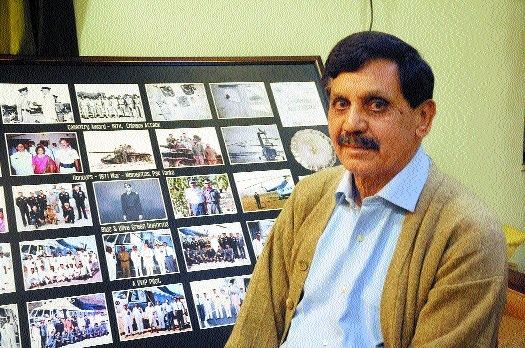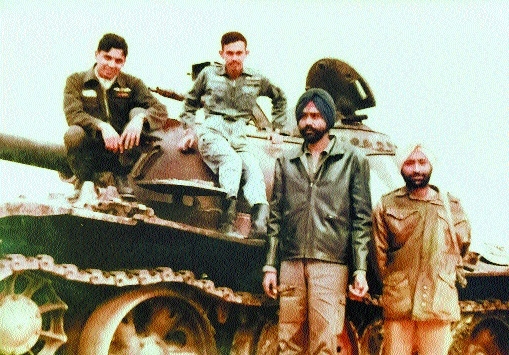‘Skill was the potent weapon for helicopter pilots in 1971 war’
| Date :04-Jan-2022 |

Group Captain A G Bendre (now retired) sitting in his house,
with a collection of his photographs taken during his service
in the IAF forming the backdrop. (Pic by Satish Raut)
By Kartik Lokhande :
Everyone knows about the famous Battle of Longewala and the valour of the Indian Army, during the 1971 Indo-Pak war. But, there is more to the story of how Pakistani tanks were destroyed with precision by the Indian Air Force (IAF). Even the IAF aircraft received precise locations of enemy tanks, from the highly skilled helicopter pilots. It is a matter of great pride that one such helicopter pilot -- Group Captain A G Bendre -- is a Nagpurian. The Battle of Longewala was one of the first major battles in the Western Sector during the Indo-Pak War of 1971, in Thar desert of Rajasthan. Major Kuldip Singh Chandpuri MVC of Punjab Regiment and his gallant action left an indelible mark in the epic battle. As per the Indian Army records, an IAF Forward Air Controller was able to secure and direct aircraft in support of the post’s defences until reinforcements arrived later. “Such was the co-ordinated assault on the enemy tanks that they lay humbled close to the International Boundary overpowered by accurate fire of RCL and fighter aircraft of the #IndianAirForce,” stated a post by the Additional Directorate General of Public Information, Integrated Headquarters of Ministry of Defence (Army).

The then Flt Lt A G Bendre (left), with the IAF and the Indian Army men, sitting on a Pakistani tank destroyed in Indian attack during 1971 war.
After 50 years, sitting in his quiet residence in a lane along Shankar Nagar Square to Ambazari T-Point road, Group Captain A G Bendre (retd) remembers the scenes vividly. Commissioned into the IAF in 1966 at the age of 24 years, he was seven years into service when the Indo-Pak war broke out in 1971. Then a Flight Lieutenant, he was posted at Jodhpur. “We were asked to move to Ramgarh, where destiny awaited me and others to participate in what came to be known as the famous Battle of Longewala,” he recalls. A highly skilled helicopter pilot, Group Captain A G Bendre flew Mi-4, Mi-8, and Mi-17 in his service. In 1971, he piloted Mi-4 helicopter. The IAF helicopters provided support to the Indian Army in moving ahead, and also in reconnaisance, evacuation of casualties, transporting manpower, and supply of ammunition.
On December 3, 1971, his unit moved to Ramgarh and they were suposed to moved to Longewala, which was encircled by Pakistani tanks. “The help of IAF was sought. However, there was a challenge -- the Pakistani tanks got a kind of camouflage in the desert because of their colour. Since our fighter aircraft of the time flew fast, they needed help in locating the tanks. Here, the not-so-fast flying helicopters came into play. We flew helicopters through the war zone, higher than our Hunter fighter aircraft, spotted the tanks, constantly communicated the accurate locations of the enemy tanks to the Hunters, which then struck the tanks. During the thick of the action, our forces destroyed more than half of 48 tanks,” Group Captain A G Bendre tells ‘The Hitavada’ in his calm yet clear voice. Though he narrated this with ease, there was high risk involved for helicopter pilots. Flying helicopters in war zone was daring. For, back then, helicopters did not have offensive capabilities. That is, the helicopters were not equipped to return the enemy fire.
“Skill was the only thing that could save us. If enemy fired at us, we could only duck the fire with skillful manouvres,” says the 1971 war veteran. After their tanks were destroyed in co-ordinated action of the Indian Army and the IAF, Pakistan Army started running back towards the International Boundary. Group Captain A G Bendre recalls that the Indian forces pushed the enemy forces back up to Naya Chhor. When the IAF helicopters went to evacuate the injured Indian soldiers from Naya Chhor, Pakistanis fired at them. “We did ducking manouvres, making good use of high sand dunes, took circuitous route, and then evacuated the injured soldiers,” he recollects. He adds, “We were at Naya Chhor till mid-1972 when the troops withdrawal began.”
During the war, like other soldiers, then Flt Lt A G Bendre also was on dry ration. However, as he recalls, after the war on December 17, 1971, he and others in his team at Naya Chhor had the first taste of warm food ‘daal-chaawal’ since the war began. Since the 1971 war, Group Captain A G Bendre acquired more and more skills. In 1974, he was decorated with Vayu Sena Medal at the hands of the then IAF Chief O P Mehra for excellent use of skills in an incident when in Chinese attack nine bullets had hit the helicopter he was flying. Asked about that incident, he replies, “We were on a special task along India-Myanmar-China triangle, when Chinese fired at our Mi-4 helicopter. Nine bullets had hit our helicopter. A bullet brushed by helmet, a senior Army officer with us got injured, and there was damage to pilot’s windshield, cabin windows, communication box. In that condition, I landed the helicopter straight in the premises of a hospital so as to get medical aid for the injured officer.” In 1985, he was Commanding Officer of a helicopter unit in Assam where he also trained the younger pilots. In 1986, in recognition of his wonderful flying skills, he was inducted into the VIP Squadron in which only highly skilled pilots get chosen after multiple tests. During that stint, he had the privilege of flying the VVIPs including the Presidents of India namely Gyani Zail Singh, R Venkataraman, K R Narayanan and others.
Also, he flew the Prime Ministers of India namely Indira Gandhi, Rajiv Gandhi, Chandrashekhar, I K Gujaral, P V Narasimha Rao. Apart from them, he also flew Sri Lankan President J R Jayewardene, Pakistan President Mohd Zia ul Haq, Prime Minister of Pakistan Benazir Bhutto, King of Bhutan and other State Guests of the time. Now, 50 years since the Bangladesh Liberation War, the war veteran is well qualified to be asked how has India evolved militarily. Group Captain A G Bendre replies, “The developments have been positive. We have got new, versatile aircraft that meet the requirement of the Armed Forces. We have better technology, manpower, training. We have got helicopters that can fly higher than the machines we had back then. Of course, today’s modern aircraft need more skills because of a plethora of functions. Overall, the situation has changed for the better.”
He is proud father of Lt Col Amit Bendre, who retired from the Army Aviation unit, and has joined a private aviation company at Mumbai. Group Captain A G Bendre’s wife Jyoti also has retired after serving for long years as Principal of Hadas English Medium School. She got the Best Teacher Award of State Government twice in her teaching career. The couple has a daughter too, who is an engineer in the US. Sitting in his house, where everything is neatly arranged, Group Captain A G Bendre takes a glance at a huge frame displaying a collection of photographs from his service years. One can be sure that each of the stills must be replaying the entire story behind, in front of his eyes. One can catch a glimpse of satisfaction, of having served the motherland when she needed the most, in his eyes. Also, one can see a gentle smile on the face of the soft-spoken gentleman, the hallmark of an Indian Air Warrior!